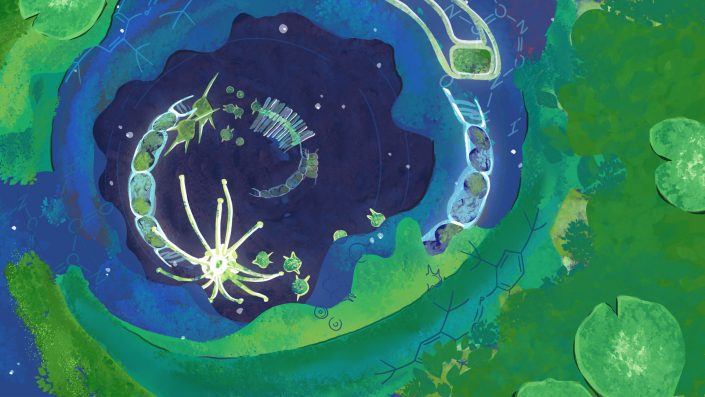Harmful algal blooms: Scientists look for methods to protect waterways

Image: Melissa Butcher, Research Communications
Researchers are searching for methods that may alleviate an increasing harmful algal bloom issue occurring across the United States. One answer, they say, could be to control the levels of nitrogen and phosphorous found in lakes and other waterways.
Harmful algal blooms, which are known for releasing deadly toxins, are caused by an overabundance of simple plants that live in bodies of water. These blooms thrive best in warmer and drier climates and can kill aquatic life, birds and mammals, and pose negative effects on the ecosystem.
Daniel Roelke, professor, Department of Wildlife and Fisheries Sciences, has dedicated much of his research to studying the driving factors that cause algal blooms to grow in certain areas. He also looks for ways to manipulate the conditions in hopes that the problem can be mitigated entirely.
“Our most recent studies have shown that phytoplankton made up of species that do not strongly compete against each other suffer more from blooms in comparison to those phytoplankton made up of species that strongly compete against each other,” Roelke said.
“The driving force behind the growth of blooms comes from the amount of nitrogen and phosphorus levels in a body of water,” he said. “If you can manipulate the hydrology in such a way so that these two chemical compounds fluctuate through time, then you can manipulate the systems so that the phytoplankton compete against each other more strongly, thus resulting in less blooms.”
The majority of the time series data used in the research has been performed in lakes in Europe. However, department scientists are developing and testing methods to use in Texas’ lakes, estuaries and bays.
“The harmful algal bloom issue is increasing in frequency and magnitude as we speak, but we hope that the research studies we’ve conducted will bring us closer to mitigating the problem and finding a solution,” Roelke said, “not only for ecological reasons, but also for the sake of human health.”
To support Roelke’s research, Texas A&M graduate student Rika Muhl completed a study that focuses on the environmental conditions that can affect phytoplankton.
“Just like humans, phytoplankton need certain resources to survive, such as nitrogen, phosphorus, carbon or vitamins,” said Muhl. “The duration and intensity of harmful algal blooms is reduced when the need for those resources in phytoplankton groups is dissimilar, meaning one phytoplankton may need more nitrogen than another, and vice versa. Therefore, if we can identify and manage environmental conditions that promote healthy and diverse phytoplankton groups, we can create an environment that prevents the reproduction of out-of-control algal blooms.”
A large percentage of the funding for Roelke’s algal bloom research comes from sources interested in combatting the problem, such as the federal government, the Texas Parks and Wildlife Department, the Texas Commission on Environmental Quality and the Texas Water Development Board.

